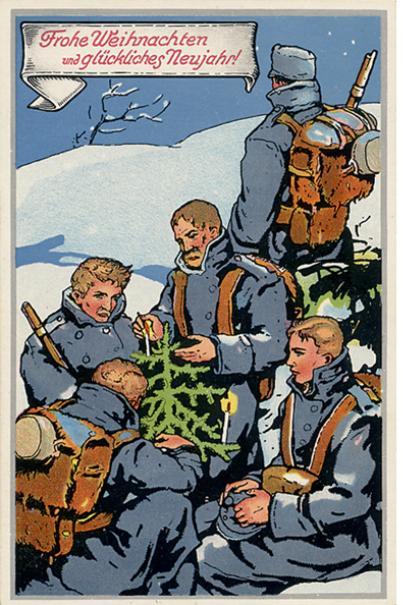The Christmas Truce is one of the few positive events of World War One that is still widely remembered today. Here, Rebecca Fachner explains what happened during Christmas 1914, and how soldiers on different sides in the war showed their common humanity.

Frohe Weihnachten und glückliches Neujahr (Merry Christmas and a Happy New Year in German). From a festive World War One card.
The Christmas season is now upon us, and with it, the true story of a true Christmas miracle, the Christmas truce in 1914 in the midst of World War One.
The beginnings of World War I have already appeared in this space, and by December 1914, Europe was 5 months into the most brutal warfare that anyone could remember. It seemed that humans lost control and that the world had been turned upside down. Everyone was now realizing that they were in for a long war. Gone were the predictions of a 90-day war, of easy victory, heroism and bravado. As December began, troops on all sides grasped that boasts of “home for Christmas” were not going to be anywhere close to a reality. All sides were beginning to understand that they were enmeshed in a protracted battle, and that it wasn’t going to remotely resemble their pre-war dreams of glorious battles for king and country. This conflict had been and would continue to be brutal, degrading and all but unbearable.
By December troops were dug in along the Western Front in trenches that stretched for miles, staring down the enemy in their own trenches. In between was a no mans land of barbed wire and dead bodies. Trenches were typically between 90 and 275 meters (100 to 300 yards) apart, so the enemy was very much within visual range. The week before Christmas British and German troops began to exchange season’s greetings, and sang Christmas carols together. In some places, troops began to actually go into no mans land to give gifts of food, cigarettes and souvenirs. On Christmas Eve and Christmas Day, many troops ventured out of their trenches to greet their enemies, converse and enjoy holiday cheer. Some used this as an opportunity to recover bodies that had been left in no mans land, and there were reports of several joint burials. In many places, however, the celebration was much more lively, and shared meals were reported, as well as several soccer (or football in British English) games. Most of the football games were comprised only of allies, but here and there along the front, enemies came together to organize football games together.

British and German troops together during the 1914 Christmas Truce. December 26, 1914.
Different truces
The name for it, the Christmas Truce, implies some sort of official truce or formal recognition of the events, but in fact there was really nothing of the sort. These truces were in no way official, nor were they encouraged or even sanctioned by the command structure of either side. Rather they were spontaneous demonstrations of Christmas cheer from troops who had a desire to put down their weapons and celebrate with their enemies. The truce did not encompass the entire Western Front, it was much more individual and grassroots led. Some units did not observe a truce at all; in fact, in some places there was fighting over the Christmas period. In some areas the Truce was little more than a completely informal ceasefire for the day, nothing formal, just an observance of the holiday. Others used the opportunity to collect their unburied dead.
It must be said that the Truce was mainly between the British and the Germans on the Western Front. The French did participate, but to a much lesser degree, possibly because the Germans had actually invaded their country. There was even a Christmas Truce in the East, which looked very different when compared to that in the West. In the East, Christmas celebrations were complicated by the fact that the Russian Orthodox Christmas is celebrated later, in early January. The truce in the East was more formal, too, with the impetus coming from somewhere in the Austrian military hierarchy. The Austrians had the idea for a ceasefire, and the Russians responded positively, and so the Austrian army was ordered not to fire unless provoked on Christmas. One unit in Galicia even brought a Christmas tree into no mans land, and in several places the two sides met to exchange gifts of schnapps and food. A few days later, when the Russian troops celebrated Orthodox Christmas, Austrian troops held their fire to allow the Russians to celebrate.
Christmas 1915
The Christmas Truce was not received as well by the military hierarchy on the Western Front. Both sides independently agreed that the Truce had been an inexcusable breach of military discipline, and a frightening opportunity for significant fraternization with the enemy. Military command was worried that the Truce was a tacit renunciation of the war and of non-cooperation by the enlisted, while it gave troops the opportunity to humanize their enemy. For this reason, Christmas 1915 looked very different, with many commanders forbidding fraternization, and some even ordering raids and artillery bombardments specifically for Christmas. There were very small-scale attempts at a truce in 1915 and later, but they were largely unsuccessful.
The Christmas Truce of 1914, 100 years ago this Christmas, is a wonderful example of the human spirit triumphing over the brutality of war. It provides an all too rare glimpse into the human side of World War One, something apart from the killing and suffering.
Did you enjoy this article? If so, tell the world! Tweet about it, like it, or share it by clicking on one of the buttons below!
Now, you can read Rebecca’s article on how World War One’s Eastern Front differed from the Western Front here.
